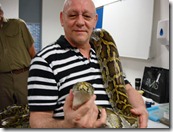I recently returned from my annual pilgrimage to Walt Disney World where we rode on the “Haunted Mansion” ride at the “Not so scary Halloween” evening.
In the US, people tend to make more effort to celebrate events like Halloween but in the UK we are catching up. I thought what do I actually know about Halloween?
The following article is from halloweenishere.com which is full of information about Halloween and includes:
Fun & Games ![]() Ghost Stories
Ghost Stories ![]() Rancid Recipes
Rancid Recipes ![]() Costume Ideas
Costume Ideas ![]() Safety Tips
Safety Tips
Haunted House ![]() HIH Store
HIH Store ![]() Haunted Art
Haunted Art ![]() Buried Alive
Buried Alive ![]() Ghoul School
Ghoul School ![]() History
History
Send A Card ![]() Contest
Contest ![]() Graveyard Links
Graveyard Links ![]() HIH Award
HIH Award ![]() Link To Us
Link To Us
The history of Halloween and fun pumpkin facts!
Halloween, one of the world's oldest holidays, is still celebrated today in several countries around the globe. The autumn rite is commemorated in the United Kingdom, although with a surprising and distinctive British twist. In Mexico, Latin America, and Spain, All Souls' Day, the third day of the three-day Hallowmas observance, is the most important part of the celebration for many people. In Ireland and Canada, Halloween, which was once a frightening and superstitious time of year, is celebrated much as it is in the United States, with trick-or-treating, costume parties, and fun for all ages.
The word itself, "Halloween," actually has its origins in the Catholic Church. It comes from a contracted corruption of All Hallows Eve. November 1, "All Hollows Day" (or "All Saints Day"), is a Catholic day of observance in honour of saints. But, in the 5th century BC, in Celtic Ireland, summer officially ended on October 31. The holiday was called Samhain (pronounced sow-in), which means "end of summer", the Celtic New year.Trick for Treat
The custom of trick or treating probably has several origins. During Samhain, the Druids believed that the dead would play tricks on mankind and cause panic and destruction. They had to be appeased, so country folk would give the Druids food as they visited their homes.
An old Irish peasant practice called for going door to door to collect money, breadcake, cheese, eggs, butter, apples, etc., in preparation for the festival of St. Columb Kill.
Also a ninth-century European custom called souling. On November 2, All Souls Day, early Christians would walk from village to village begging for "soul cakes" made out of square pieces of bread with currants. The more soul cakes the beggars would receive, the more prayers they would promise to say on behalf of the dead relatives of the donors. At the time, it was believed that the dead remained in limbo for a time after death, and that prayer, even by strangers, could expedite a soul's passage to heaven.Did You Know...
- A traditional food eaten on Halloween is barnbrack, a kind of fruitcake that can be bought in stores or baked at home. A muslin-wrapped treat is baked inside the cake that, it is said, can foretell the eater's future. If a ring is found, it means that the person will soon be wed; a piece of straw means that a prosperous year is on its way.
Bobbing for Apples
When the Celts were absorbed by the Roman Empire, many rituals of Roman origin began. Among them was the worship of Pomona, goddess of the harvest, often portrayed sitting on a basket of fruits and flowers. Apples were the sacred fruit of the goddess, and many games of divination involving them entered the Samhain customs.
The Witch's Broomstick
The witch is a central symbol of Halloween. The name comes from the Saxon wica, meaning wise one. When setting out for a Sabbath, witches rubbed a sacred ointment onto their skin. This gave them a feeling of flying, and if they had been fasting they felt even giddier. Some witches rode on horseback, but poor witches went on foot and carried a broom or a pole to aid in vaulting over streams. In England when new witches were initiated they were often blindfolded, smeared with flying ointment and placed on a broomstick. The ointment would confuse the mind, speed up the pulse and numb the feet. When they were told "You are flying over land and sea," the witch took their word for it.Jack-O-Lanterns
Irish children used to carve out potatoes or turnips and light them for their Halloween gatherings. They commemorated Jack, a shifty Irish villain so wicked that neither God nor the Devil wanted him. Rejected by both the sacred and profane, he wandered the world endlessly looking for a place to rest, his only warmth a glittering candle in a rotten turnip. Read about Jack in the 'Legend of the Jack-O-Lantern' short story.
Did You Know...
- The Irish Potato Famine (1845-50) prompted over 700,000 people to immigrate to the Americas. These immigrants brought with them their traditions of Halloween and Jack o'Lanterns, but turnips were not as readily available as back home. They found the American pumpkin to be a more than an adequate replacement. Today, the carved pumpkin is perhaps the most famous icon of the holiday.
Halloween Masquerade Mask
From earliest times people wore masks when droughts or other disasters struck. They believed that the demons who had brought their misfortune upon them would become frightened off by the hideous masks. Even after the festival of Samhain had merged with Halloween, Europeans felt uneasy at this time of the year. Food was stored in preparation for the winter and the house was snug and warm. The cold, envious ghosts were outside, and people who went out after dark often wore masks to keep from being recognised.Pumpkin Facts
- In 1584, after French explorer Jacques Cartier explored the St. Lawrence region of North America, he reported finding "gros melons." The name was translated into English as "pompions," which has since evolved into the modern "pumpkin."
- Pumpkins have been grown in North America for five thousand years. They are indigenous to the western hemisphere.
- Pumpkins are fruits. A pumpkin is a type of squash and is a member of the gourd family (Cucurbitacae), which include squash, cucumbers, gherkins, and melons.
- Pumpkin seeds should be planted between the last week of May and the middle of June. They take between 90 and 120 days to grow and are picked in October when they are bright orange in colour. Their seeds can be saved to grow new pumpkins the next year.
- 2007 New World Record! In what has become an annual event, the world record has fallen once more. The largest pumpkin ever grown stands at 1,680 pounds. It was grown by Joe Jutras of Rhode Island. It was weighed in on October 7, 2007 at the Rhode Island Weigh-off. Will the record fall again in 2008? I will let you know
EnJoY!
Source halloweenishere.com Image factoidz.com



![laughing_face[1] laughing_face[1]](http://lh4.ggpht.com/_jXcDWcGiFlI/TJdb33h9ZYI/AAAAAAAAAQ0/SG8CqPYwb68/laughing_face%5B1%5D%5B4%5D.png?imgmax=800) Ol' Fred had been a religious man who was in the hospital, near death. The family called their preacher to stand with them. As the preacher stood next to the bed, Ol' Fred's condition appeared to deteriorate and he motioned frantically for something to write on.
Ol' Fred had been a religious man who was in the hospital, near death. The family called their preacher to stand with them. As the preacher stood next to the bed, Ol' Fred's condition appeared to deteriorate and he motioned frantically for something to write on. 
![720_criminal_minds_468_2[1] 720_criminal_minds_468_2[1]](http://lh6.ggpht.com/_jXcDWcGiFlI/TIbj4QGufzI/AAAAAAAAAQU/NOfaS6v8BCw/720_criminal_minds_468_2%5B1%5D%5B3%5D.jpg?imgmax=800)


![usb-hamster[1] usb-hamster[1]](http://lh6.ggpht.com/_jXcDWcGiFlI/TIoe2jrF68I/AAAAAAAAAQY/fv0Hq4nWszs/usb-hamster%5B1%5D%5B3%5D.jpg?imgmax=800)



![partner_image[1] partner_image[1]](http://lh4.ggpht.com/_jXcDWcGiFlI/TIagqFzJkMI/AAAAAAAAAQM/iV4qjv1QIe4/partner_image%5B1%5D%5B7%5D.jpg?imgmax=800) Finally his exasperated partner says, "What's taking so long? Hit the blasted ball."
Finally his exasperated partner says, "What's taking so long? Hit the blasted ball." ![drphil1[1] drphil1[1]](https://blogger.googleusercontent.com/img/b/R29vZ2xl/AVvXsEga_LNnCcDRU7k9LrY9FyNO7JRvzCYITGPBc7pWwQa_CAuL5PFXhtXFjtvdiFcN1hecS5bc1NfwfRP_n3xKH6_ovxeNrvQAPhnFP4wWzn3-kX9rR7cIxr8FOQ1iXhwKjTDwbNkEwk09RH4/?imgmax=800)
![alex02flip[1] alex02flip[1]](http://lh4.ggpht.com/_jXcDWcGiFlI/TIqE2Vi4ONI/AAAAAAAAAQc/5qgMZOkjnaM/alex02flip%5B1%5D%5B6%5D.jpg?imgmax=800)
![alex01c-full[1] alex01c-full[1]](http://lh6.ggpht.com/_jXcDWcGiFlI/TIqE264o1JI/AAAAAAAAAQg/SFzEN_6yLec/alex01c-full%5B1%5D%5B11%5D.jpg?imgmax=800)
![social_every-picture-tells-a-story[1] social_every-picture-tells-a-story[1]](http://lh4.ggpht.com/_jXcDWcGiFlI/TIad9PlFavI/AAAAAAAAAQE/ZdRmC7gyQPU/social_every-picture-tells-a-story%5B1%5D%5B7%5D.jpg?imgmax=800)

 One night, a torrential rain soaked South Louisiana; the next morning the resulting floodwaters came up about 6 feet into most of the homes there.
One night, a torrential rain soaked South Louisiana; the next morning the resulting floodwaters came up about 6 feet into most of the homes there. 
 Customer service
Customer service 


![normal_Charles_Barkley[1] normal_Charles_Barkley[1]](http://lh3.ggpht.com/_jXcDWcGiFlI/TIFtq5Wa83I/AAAAAAAAAPM/2INCdLrKvyo/normal_Charles_Barkley%5B1%5D%5B5%5D.jpg?imgmax=800)
![image_thumb3[1] image_thumb3[1]](http://lh3.ggpht.com/_jXcDWcGiFlI/TIQy58Gn3YI/AAAAAAAAAPg/Sc2dqraKMuA/image_thumb3%5B1%5D%5B4%5D.png?imgmax=800) The statement can not be true because it pre supposes that by looking at the past will let us see the future. We cant see unless we get some magical spectacles and since we can’t go to the past, we will never get to try on the wonder glasses anyway!
The statement can not be true because it pre supposes that by looking at the past will let us see the future. We cant see unless we get some magical spectacles and since we can’t go to the past, we will never get to try on the wonder glasses anyway! ![dr-phil[1] dr-phil[1]](https://blogger.googleusercontent.com/img/b/R29vZ2xl/AVvXsEjDyN8qcw6ixIhX0yv76dDy5G3H2pgHIGPmj8lKWhAbz1JM3TaL7q2bdemhYSCU31OsWkud0C2nc0kWqe8PQ_0arJQZvbP9Nkj1lwpj49FgfhbQe3zveZ2dLFxZVBEJ_TOhVWr2o5k87fM/?imgmax=800)
![image49[1] image49[1]](https://blogger.googleusercontent.com/img/b/R29vZ2xl/AVvXsEjUhx5bHEbBJaZmlL8mJoF3oP59rwn-UlN_q8plRu8mamREzlD6MjvAo5dedlZ6q14pBLlWgbaNx0Wz9tEoHj8v5DA62enZfcWI5Hyw_baduUq-n-Cji9ySLkhVSqxUayfPADClk6sGSGY/?imgmax=800)
![rron71l[1] rron71l[1]](http://lh6.ggpht.com/_jXcDWcGiFlI/TIZfg5QQLDI/AAAAAAAAAP0/23AmyDCBJdU/rron71l%5B1%5D%5B4%5D.jpg?imgmax=800)


![imagesencartamsn[1] imagesencartamsn[1]](https://blogger.googleusercontent.com/img/b/R29vZ2xl/AVvXsEh-yzTL1dR1xlfE6u09nXorn1tf4z1EXNmZ_rjUvIYJQGub1Uxal73E0S4gvi7q7Ib-Roeu5jSENBkxZEw_pVbVuI1w_q9ZSHl4cejzfdfK3CQH-4kwzT0313qHZ7vz_AW_iKMJZDJUJV4/?imgmax=800)

![snoring[1] snoring[1]](https://blogger.googleusercontent.com/img/b/R29vZ2xl/AVvXsEiRRPFNxpzePTosbDEdHsAo6DqESVyVBF1Qvyq1Q7D89HMvngpyAabybAt4N0d-AvIW7XhywOZfzXebjZ6ZqLZSM1ubslNN8_r_pv2sAxe5p_zyuwWMQ998_fnI2_fov25ukChPSwZU4lk/?imgmax=800)

![Spinning_Dancer[1] Spinning_Dancer[1]](http://lh5.ggpht.com/_jXcDWcGiFlI/TH-Rbnm_zcI/AAAAAAAAAPA/faJSVJBKQ9g/Spinning_Dancer%5B1%5D%5B5%5D.gif?imgmax=800)